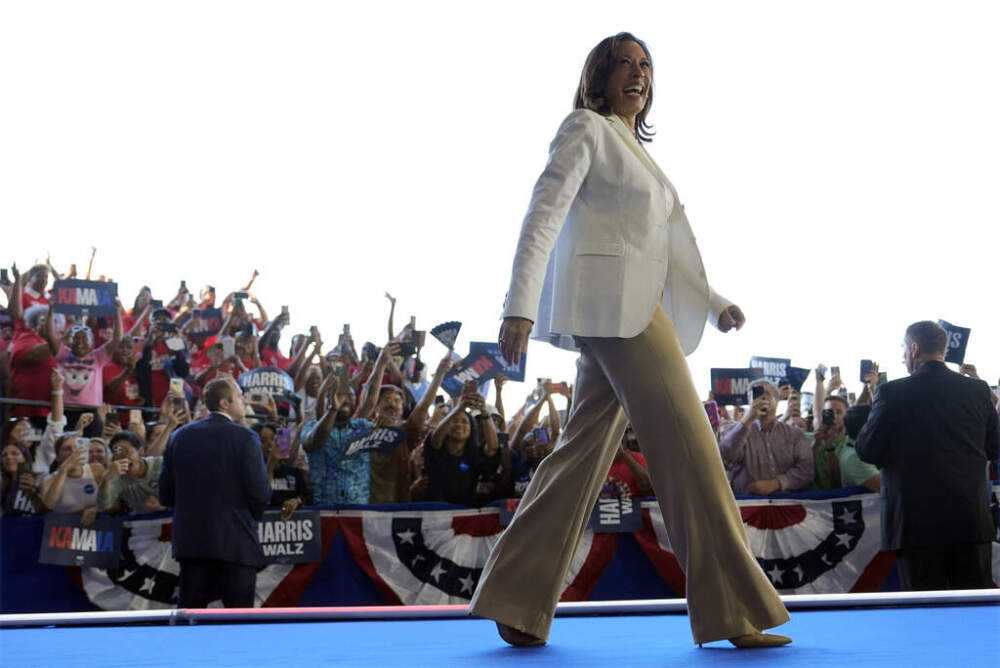Commentary

The Sunday afternoon President Biden stepped back from the 2024 race, I was on the phone with my mom. “Well, Kamala is the obvious pick,” we agreed. Later that day after Biden’s support for the vice president was announced, I was on several text threads, most of them echoing something like this: “I’m so excited about Kamala;” “Come on, Kamala;” “Kamala looks great;” “Very excited about Kamala!” and simply “Kamalaaaaaaaa.”
No one referred to her as “Vice President Kamala Harris,” the VP, Kamala Harris, or even simply Harris. And while it may seem trivial, before this goes any further, we need to start calling the vice president by her full name.
A 2022 Mayo Clinic study found that female doctors were twice as likely to be called by their first name compared with their male counterparts. And this happens across professions and class lines — even to first ladies like Dr. Jill Biden who happen to also be college professors. A Cornell University report from 2018 noted how this discrepancy starts young — college students were nearly 56% more likely to call a male professor by his last name on the review site Rate My Professor. Male and female doctors, professors, and even vice presidents all have to earn their degrees and titles the same way, and yet we insist on calling professional women by their first names.
Of course, it’s not that we never call men by their first names. Saying “Joe” connotes images of the president’s humble Scranton upbringing, and “Sleepy Joe” is the GOP’s favorite insult. But more often than not, he’s Joe Biden, President Biden or just Biden. On the other side, Donald Trump historically reveled in being called “the Donald,” but since his term as president and in his subsequent political life, it’s almost always Trump, former President Trump or Donald J. Trump. It’s hardly a coincidence. Just last week, Trump doubled down on not only using Harris’ first name, but mispronouncing it. It’s become a way of mocking her campaign and casting doubt on Harris’ background and upbringing.

In sharp contrast, Stephen Colbert has consistently only referred to the vice president by her title or full name in his recent “Late Show” monologues, without making a thing of it. It feels reaffirming and subversive, because it is. Even “The Daily Show” used “Kamala” casually in its latest episode as did the New York Times in Thursday’s episode of The Daily — when you are listening for it everywhere (and now you will be), you’ll catch it.
NPR reported that there are actual psychological reasons for calling professional women by their first names, that collectively we want women to feel more relatable and accessible — and using first names achieves that. The vice president herself has told reporters to call her Kamala; whether that’s about being agreeable or relatable, it’s hard to say. The campaign even embraced “KamalaHQ” as their official name.
The Cornell study also found that news programs across the political spectrum were more than twice as likely to refer to a male subject by their last name; this held true even when excluding references to Hillary Clinton “whose campaign slogans often referred to her by first name (e.g., Hillary for President), suggesting that the result was not driven solely by references to her.” Speaking to the “Today” show, researcher Stav Atir, who worked on the Cornell study, said “We know the first name is kind of more associated with familiarity.” She also noted how first names mark a person as “more familiar, approachable, and a surname is a little more distant.”
All this, I admit, makes it difficult to retrain ourselves to use the formal. It’s still the right thing to do.
All this, I admit, makes it difficult to retrain ourselves to use the formal. It’s still the right thing to do. For Fast Company, gender equity experts Dr. Amy Diehl and Dr. Leanne M. Dzubinski offered suggestions on exactly how we can call out this “first-naming” when we see it. They recommend practices like responding with the vice president’s full name and title when someone refers to her only as “Kamala” in conversation and using a woman’s first name only “if she has invited you to do so, and then limit that usage to the specific context of the invitation. In formal settings, continue using her title and last name.”
There’s certainly a place for the familiarity the vice president has invited into her campaign that reaches voters across generations. I can’t get enough of the coconut tree memes and am anxiously awaiting Maya Rudolph’s return to play the vice president on “SNL” this fall. The energy is refreshing and it’s easy to get wrapped up in it. But context matters. When I started pointing this out to friends in casual conversations, I expected a lot of “so what” blowback, but instead most were grateful to be corrected and surprised at themselves for not noticing. We can and should move to the formal when we’re talking about the campaign in our workplaces, in our newsrooms and even at the dinner table.
The prospect of a Madame President — a female Commander-in-Chief — is as daunting to our ingrained language and habits as it is exciting for the furthering of gender equity. As a journalist, I can control how I refer to the vice president and set an example; as a friend and colleague I can call out this first-naming or untitling when I see it.
Referring to Vice President Kamala Harris by her title is the ultimate brat move. Let’s rise to the occasion.
Leave a Reply